This was published 2 years ago
Sacred ground: Dispute over Aboriginal landmark pits landowner against journalist, musician
In the months after landowner Adrian McMaster moved a 60-metre stretch of volcanic stones near the eel-rich waters of Lake Bolac that many believe was arranged there by the Djab Wurrung people about 1500 years ago, he commissioned a report.
Emotions were running high when national media descended on his farm in western Victoria last April. People were calling for McMaster to be prosecuted, labelling his actions a “desecration” akin to dismantling Stonehenge. Aboriginal Victoria arrived and launched an investigation which is still ongoing.
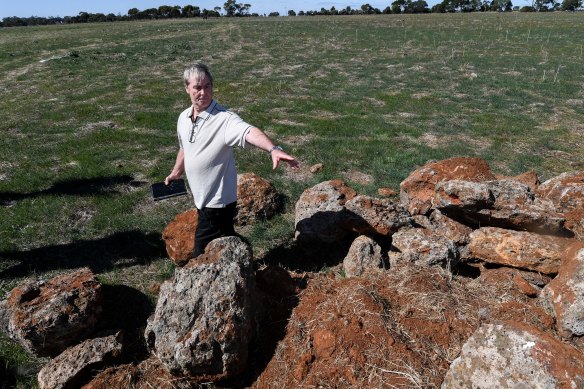
Landowner Adrian McMaster points to the rocks the removed in April 2021. He’s since commissioned a report that says the arrangement is not a sacred Aboriginal site.Credit: Joe Armao
The report McMaster commissioned disputes the long-held belief that the Kooyang (meaning eel) stone arrangement is a sacred site.
It was actually, the report says, a sheepfold or pen, dragged into place by agricultural machinery. It included photos it claimed showed the boulders moved by McMaster were put in place by workers before 1880.
His family’s connection to the region goes back to the 1860s. McMaster took over caring for the property after his father passed away four years ago.
Traditional owners reacted with shock, anger and sadness when they heard the basalt rocks that formed the tail of the 176-metre-long, eel-shaped monument had been moved to poison an infestation of thistles.
The report was filed as part of a defamation case lodged in early April by McMaster against local musician Neil Murray, who was the first to detect the disturbance of the rocks when he drove past last year and posted about it on Facebook. It is also being brought against journalist Caleb Cluff, who broke the story for Ballarat’s The Courier, and the regional newspaper’s subsidiaries that published Cluff’s work quoting Murray.
Compiled by lawyer Alan Flint and commissioned by McMaster, Sheep Fold or Stone Alignment? – An Investigation into the Aboriginal Heritage Classification of the Lake Bolac ‘Ceremonial Stone Arrangement’ argues a 1980 Victorian archaeological survey that identified two “previously unrecorded” Aboriginal stone alignment sites was mistaken.
It claims there is no “direct historical evidence” the site is ceremonial, that the authors’ findings were “fanciful” and there was “clear evidence of European construction”.
Though long, and including multiple images and extensive McMaster family history, the report doesn’t mention any consultation with local elders, Aboriginal Victoria or the government. Flint doesn’t list any professional experience in the study of Indigenous culture or history, only that he holds degrees in law and legal science. Attempts by the Sunday Age to reach him were unsuccessful.
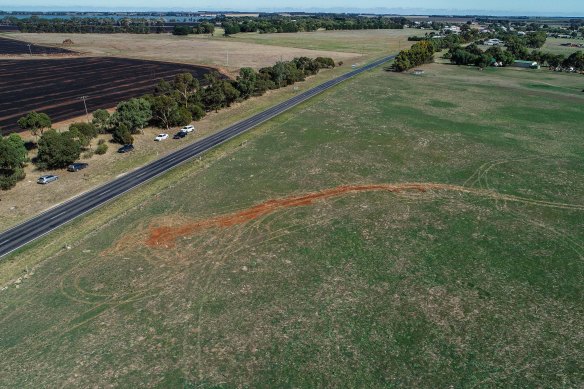
An Aboriginal stone arrangement shaped like an eel in Lake Bolac, part of which was removed.Credit: Joe Armao
Born and bred on the traditional lands of the Eastern Maar people of the region, Indigenous community leader Jason Mifsud said the claim that there was no historical evidence of the site’s ceremonial importance was wrong.
“It’s a throwback to the notion of terra nullius,” he said, referring to the since-abandoned legal doctrine used by European colonialists to justify seizing Aboriginal lands throughout Australia by claiming it didn’t belong to anyone.
“Sadly, it’s an ongoing reflection of the colonial history of this country, where an oral history that stands at 60,000 to 80,000 years old gets challenged as a matter of convenience. I don’t believe there is anything conclusive in the report,” he said.
“Our knowledge holders and elders clearly have our own experiences of that particular site. It was recorded as a site of cultural significance many years ago. Until the recent destruction of the site, it was never in contest. Now, for whatever particular reason, it is in contest.”
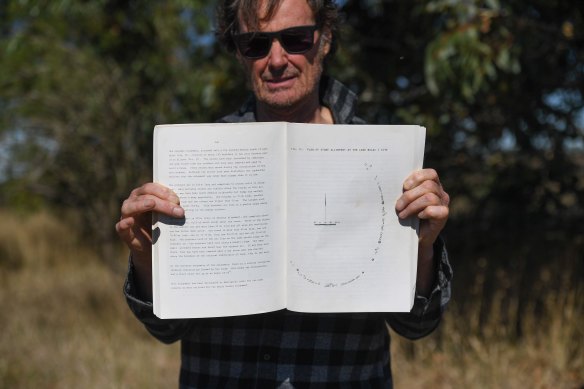
Neil Murray holds a document displaying the Aboriginal stone arrangement near Lake Bolac. Credit: Joe Armao
Murray, one of those being sued by McMaster, is a talented songwriter. He won an APRA Music Award in 1995 for writing My Island Home for Yolngu man George Rrurrambu Burarrwanga, which became a hit after it was covered by Torres Strait Islander singer Christine Anu. He also played in Warumpi Band with Burarrwanga.
Murray grew up in Lake Bolac and is known in the area for being an ardent supporter of Aboriginal rights. He has strong relationships with elders and holds cultural walks introducing people to the history of the area, including the Kooyang stone arrangement.
Flint’s report urges the government to change the register of culturally significant Aboriginal sites and remove the great eel. It criticises the research methodology of Aboriginal Victoria, saying it caused unnecessary distress in the community.
“Hopefully, archaeological assessments for [Aboriginal Victoria] are now being performed in a far more diligent and accurate and open fashion,” it says.
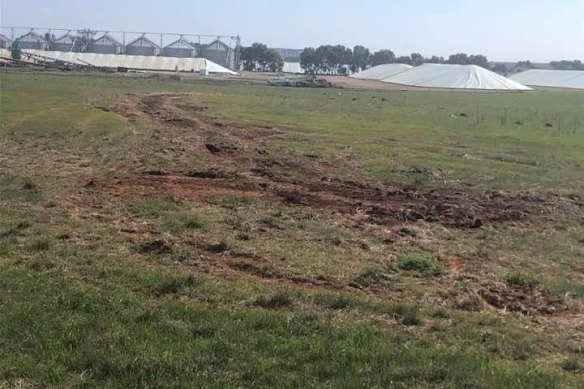
Part of the Kooyang Stone Arrangement near Lake Bolac in western Victoria was removed in April 2021.Credit: Neil Murray
”Had the affected landowner, shire and local historical organisations been given the opportunity of reviewing the original archaeologist’s manifestly erroneous report in draft form before publication, this mistake and much community angst could well have been avoided.“
McMaster is claiming Murray’s comments about him suggested he “deliberately committed a criminal act”, he’s “a malicious and devious liar”, he “disrespects and/or insults Aboriginal people and culture” and “maliciously desecrated a sacred site”.
Court documents label Murray the instigator of a demonstration, a vigil protest at the property that was “intimidating, threatening and harmful”. On legal advice, Murray would not comment on the case.
After being raised in Werribee and then working in Perth, McMaster only recently moved to the area when he took responsibility for the property after his father’s death four years ago.
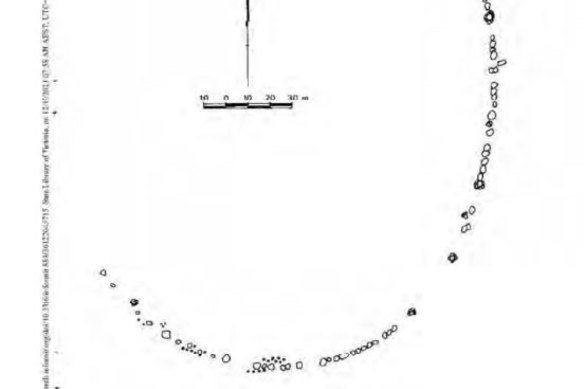
A 1980 diagram of the stone arrangement near Lake Bolac.
He said last year that he was aware that his father had taken steps 30 years ago that were aimed at ensuring Aboriginal people could take care of the stones. However, he said, the arrangement had sat untended in a paddock, creating a fire hazard when it became overgrown.
Last year he said “we deeply regret the upset and the pain we have unconditionally caused to many people and we would welcome the assistance of the Eastern Maar Aboriginal Corporation in the restoration of these stones”. However, his view of the incident appears to have shifted.
“[Murray]’s publication of claims of “destruction” of the arrangement were exaggerated and false and unjustified, as was his claim of knowledge of its purpose, origins, extent, discovery, assessment, listing and/or mapping as a protected area justifying prosecution of [McMaster],” the court documents say.
“Especially given the study designating it as Aboriginal was contradicted by the evidence.”
McMaster also makes the unsupported claim, in legal documents, that Murray had “a motive of obtaining rights over the property for himself … in order to promote his business”, and says Murray hasn’t apologised.
McMaster also claims reporters mistook him for his brother, John, who was also present on the day the vigil took place, and who he says looks like him and engaged with the media. There is no statement by his brother in the legal documents presently filed in court. Repeated requests for comment by the Sunday Age to McMaster’s lawyer went unanswered.
The matter could potentially litigate the dimensions and validity of Aboriginal cultural history as part of a case brought by a white landowner, against a white musician over comments printed by a white journalist.
Representatives of the Eastern Maar Aboriginal Corporation, which manages native title rights for the region where the stone arrangement is located, declined to comment, saying they did not want to speak while the inquiry was ongoing. Cluff also would not comment except to say he stood by his journalism.
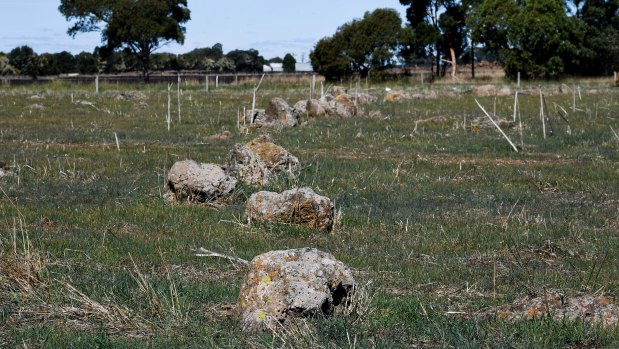
A section on the Aboriginal stone arrangement that was not removed.Credit: Joe Armao
Before European settlement, up to 1000 Indigenous people traditionally gathered each autumn as Lake Bolac overflowed and eels were released into Salt Creek, which connects to the Hopkins River and, eventually, the Southern Ocean.
Eels were harvested for feasting. Cultural heritage experts say it was likely the stones were the site for ceremonies to ensure a bountiful harvest. One of Lake Bolac’s principal attractions remains an annual Eel Festival.
The boundaries of the Eastern Maar people’s land are vast. They stretch down the Great Ocean Road, touch Lorne, Port Fairy and reach to the Grampians, Mifsud said.
“We’re not talking about subjective history and heritage here, we’re talking about tangible heritage, which makes this so much more confronting for people in our community” Mifsud said.
“If that’s up for contest, it creates a lot of trepidation for what else is at the whim of pastoralists and agriculturalists and other industry to damage our history and heritage.
“We don’t have a lot left, and what we do, we have to fight for.”
With Tony Wright
The Morning Edition newsletter is our guide to the day’s most important and interesting stories, analysis and insights. Sign up here.